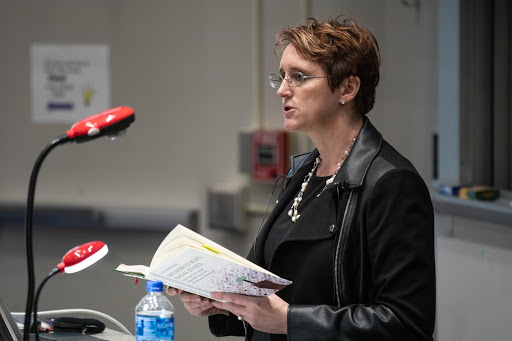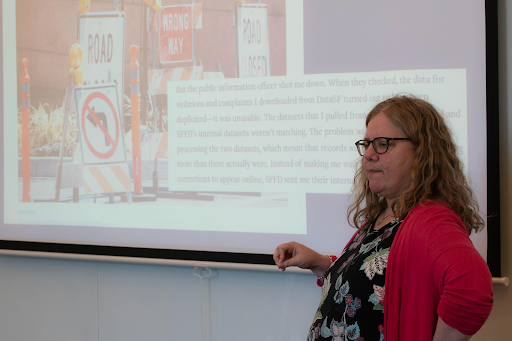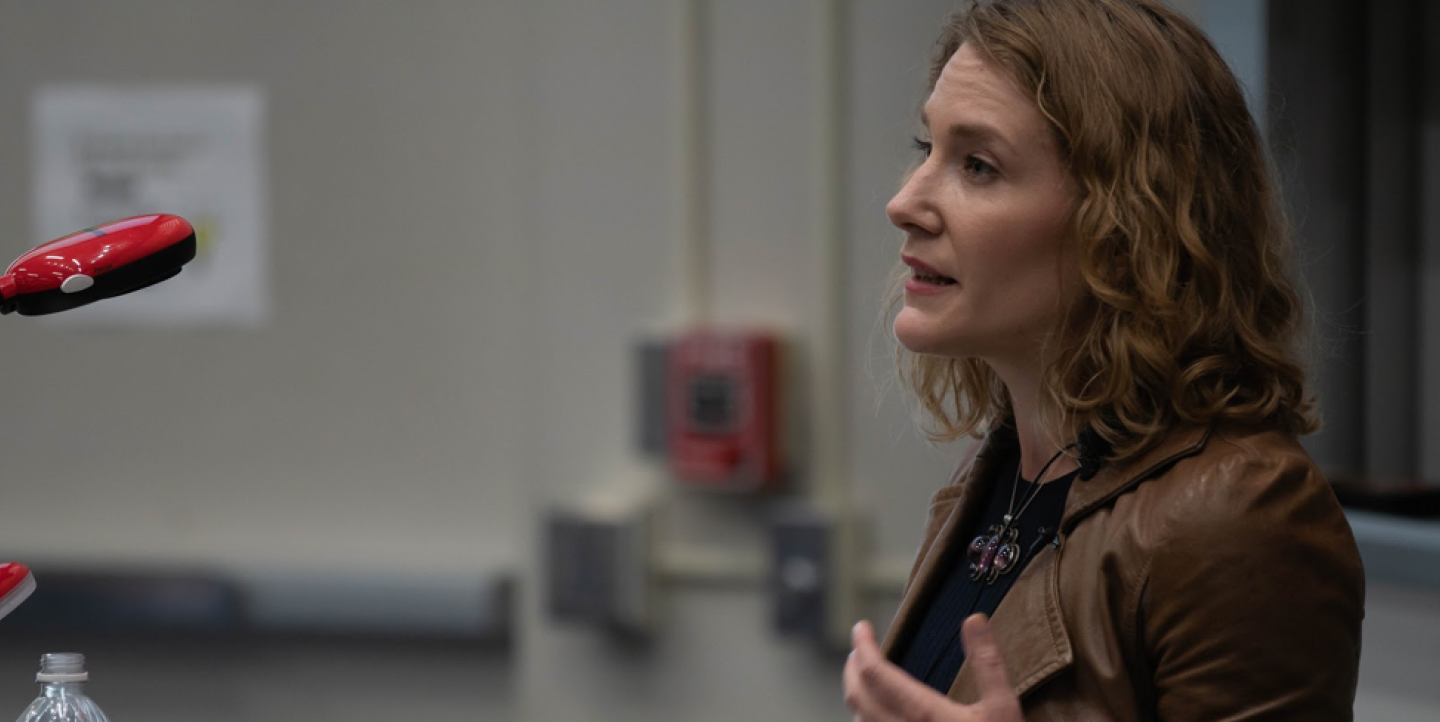Women have been fighting for equality and their place in the workforce for decades, and while successful in some cases, the battle still continues. For women in media, careful consideration for diversity and actively supporting each other plays a key role in navigating gender normative roles in the workplace.
Each term, the University of Oregon invites leading media professionals and academics to participate in the “Demystifying Media” seminar series, launched in 2016. While the seminar speakers come from a diverse pool of media professionals, the series’ latest term featured four women — a first in the seminar’s history.
Last spring, award-winning data journalist Jennifer La Fleur, journalism professor Dr. Susan Robinson, climate change researcher Rosalind Donald, and McClatchy’s Mandy Jenkins, at the time a JSK Fellow at Stanford, spoke to students and faculty.
Alongside sharing details of their work, they shared their own experiences as women in the media industry. Based on one-on-one interviews, here are some of their key reflections on the opportunities — and challenges — for women in media.
Quotes have been edited for brevity.
Mandy Jenkins, McClatchy

While many journalists abide by the motto “don’t read the comments,” Mandy Jenkins, the General Manager for The Compass Experiment, a local news laboratory founded by McClatchy and Google, said reading and responding to people who care enough to engage with them is an important part of a journalist's job. Engaging is also a key tenet of social journalism, which is using social media to engage audiences, distribute information and more.
“I think the rise of social journalism is very much tied to the rise of women,” said Jenkins. “There are a lot of women that are making big impacts in journalism, but we’re still not seeing that change at the top. I think that’s going to take a lot longer.”
“I have my own theory as to why women are being able to make big leaps in journalism right now,” she added. “At one time women were regulated into arts and community coverage. Later on, for example, when I came into the field, it was all social journalism jobs.”
Jenkins said that when she entered the field, jobs in digital journalism, social media and community engagement were not as sought after and considered “low on the totem pole.” Print was still at the forefront of journalism, so it was easy for women to slip into those jobs and, as a result, women came to dominate those positions.
“Women have been able to rise up through the ranks in these jobs because they used to be ones that no men wanted. With the jobs having gotten bigger, the women in these positions have been getting bigger. A lot of these women are slowly moving into high up positions, like top editor positions now.”
Jenkins visited the University of Oregon as a Journalist in Residence during her time as a 2019 John S. Knight Fellow at Stanford University. During her lecture, she discussed her career and recent research into disinformation and mainstream news.
Rosalind Donald, Columbia University
Rosalind Donald is a former journalist and deputy editor of Carbon Brief, a fact‐checking website focused on climate science and policy in the media. Currently a Ph.D. candidate and researcher at Columbia Journalism School, her work focuses on community understanding of climate change; a topic she argued could be a part of any journalistic beat.
“Reporting on climate change or science can be difficult,” said Rosalind Donald, a former journalist and deputy editor of Carbon Brief and a current Ph.D. candidate and researcher at Columbia Journalism School. “You have people saying you shouldn’t be in this area because it’s a science area. Women in science and in complex fields deal with that every day. It’s not just journalists.”
Journalism requires long hours and often large assignments that can pull a journalist away from their family often enough to upset a balanced home life. Women are being asked to choose between their careers and their children or starting a family. Editors and fellow journalists who ask them to choose, or shun them for not “choosing” journalism, are failing mothers in the newsroom.
Donald agrees that being a woman in media is a struggle, but being a woman of color, or even a mother can be even more difficult.
While conversations surrounding gender bias and the need to increase diversity in the newsroom continue, women of color and women who are mothers continue to struggle for representation and support.
In addition life choices and fighting for representation, women journalists are also battling for respect and safety when it comes to being a journalist. Where do you interview — where is it safe? What if your interview subjects hit on you? It doesn't always happen, but it can make you feel like they weren't seeing you as a professional doing a job to begin with.
“There are lots of things that people say to you to make you feel like you don’t belong. I'm not in my 20s anymore, I’m married, I’m a white woman, so my experience is still much more positive than for a lot of other people.”
Donald’s work focuses on community understanding of climate change, a topic she argued could be a part of any journalistic beat. Listen to her lecture here.
Professor Susan Robinson, University of Wisconsin-Madison

According to a report by Poynter, women are dominating journalism schools, but that’s not the case in the newsroom. A study by the Columbia Journalism Review shows that diversity in newsroom leadership needs reform. Out of 135 of the nation’s most widely distributed English-language newspapers, 73% of the editors are male, and 90% are white.
“I feel like we’re definitely making a lot of strides with gender equity in the newsroom. [But] less so in journalism schools, and lesser in the upper level,” said Dr. Susan Robinson, the University of Wisconsin-Madison Helen Firstbrook Franklin Professor of Journalism research chair.
Robinson covered business, technology and agriculture — all industries dominated by men — and said her gender created challenges. “Especially with my sources because wives would get annoyed that I was having coffee with their husbands,” she recalled. “There were always these rumors which of course weren’t true, but that’s the way it was. It was really hard.”
Sources would call her pet names and comment on her appearance. “It was bad — it was just constant,” said Robinson. “But that was all outside my newsroom. I was really lucky in my newsrooms. They were almost all about equal.”
Central to Robinson’s work is information flow as it moves through specific media ecologies and networks at the local community level. Listen to her discuss her new book, Networked News and Racial Divides: how power and privilege shape progressive communities.
Jennifer LaFleur, Investigative Reporting Workshop

“I was basically discouraged from doing math and science and things like that when I was in school,” said Jennifer LaFleur, the data editor for Investigative Reporting Workshop and an instructor of data journalism at American University. However, she was defiant, and pursued a career in data journalism — then called computer-assisted reporting (CAR) — anyway.
Over the years, LaFleur has watched the industry grow, especially in terms of gender parity. She remembers when she first entered the field, she attended an event for women, and only five showed up.
Now, women comprise roughly half of conference attendees, according to LaFleur, and the last time they tried to hold a similar event for women, they couldn’t find a space large enough.
“It’s the only place I get super happy when I have to wait in line to the bathroom,” she said
According to LaFleur, it’s everyone’s responsibility to bring more diversity into the field.
“When I'm building a team, I definitely try to hire young women and journalists of color, because I heard for so long that it's just it's really hard to get people to have a diverse newsroom and have a diverse team and that’s a bunch of bologna.”
Mentoring programs and fellowships are a great place for more seasoned journalists to find new and up and coming journalists to bring along and help them grow. Having a variety of new and fresh perspectives can improve the newsroom and the quality of journalism being written.
“When we have other women succeed, we all succeed.”
In partnership with The Catalyst Journalism Project, LaFleur discussed how to avoid mistakes with data journalism during her guest lecture. You can listen to it here.
Explore more conversations with these speakers, via the Demystifying Media podcast (SoundCloud, iTunes) and these short 10 minute studio interviews.
Destiny Alvarez is a journalist based in Portland, Oregon. She graduated from the University of Oregon School of Journalism and Communication (SOJC) with a Master’s in Journalism in 2019. Alvarez was the 2019 Editor-in-Chief of the award-winning student-led SOJC publication Flux Magazine. Alvarez served as the Spring 2019 Demystifying Media Intern and the 2019 Charles Snowden Program for Excellence in Journalism intern for The Register-Guard in Eugene, Oregon.
Main image shows Rosalind Donald, courtesy of OR Media.

